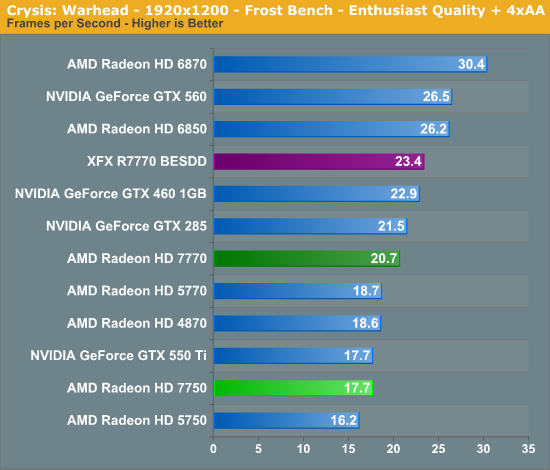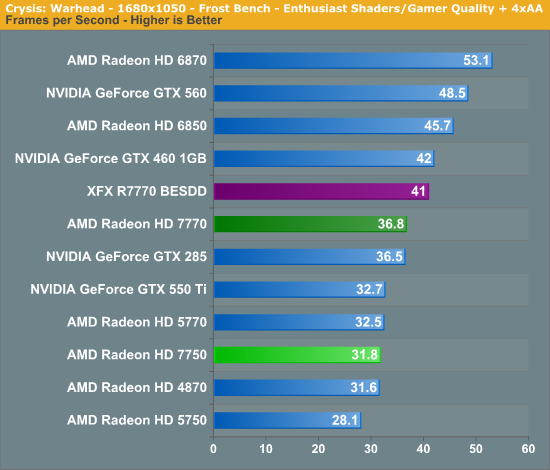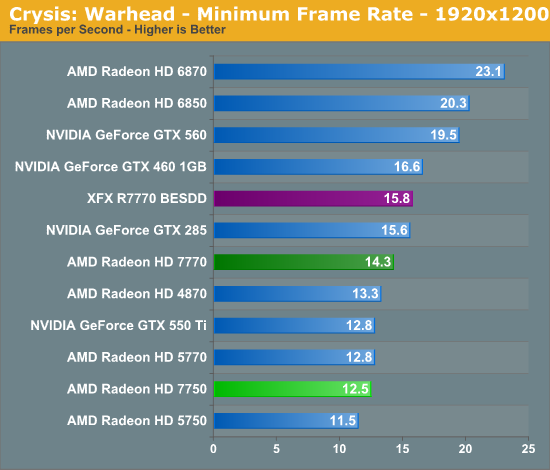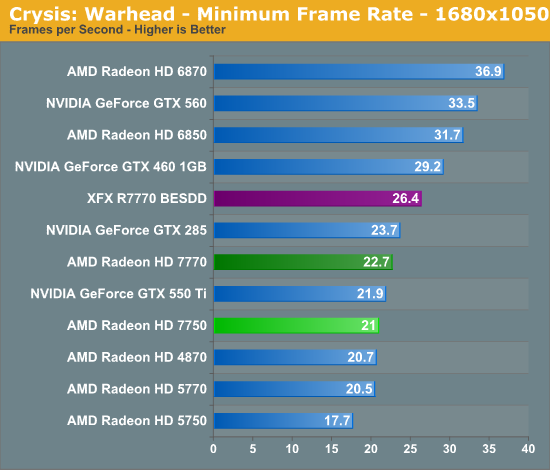AMD Radeon HD 7750 & Radeon HD 7770 GHz Edition Review: Evading The Price/Performance Curve
by Ryan Smith & Ganesh T S on February 15, 2012 12:01 AM EST- Posted in
- GPUs
- AMD
- HTPC
- GCN
- Radeon HD 7000
Crysis: Warhead
Kicking things off as always is Crysis: Warhead. It’s no longer the toughest game in our benchmark suite, but it’s still a technically complex game that has proven to be a very consistent benchmark. Thus even four years since the release of the original Crysis, “but can it run Crysis?” is still an important question, and the answer continues to be “no.” While we’re closer than ever, full Enthusiast settings at a 60fps is still beyond the grasp of a single-GPU card.


With AMD’s GCN architecture, Crysis is finally losing some of its predictive power, but it’s still a good indicator of overall performance. And the indicators aren’t very good.
From a price/performance perspective the 7700 needs to beat at least the 6850 on the AMD side and at least the GTX 560 on the NVIDIA side in order to ensure a clear-cut victory. Unfortunately it’s falling well short of that, underperforming the 6850 by 20% never mind the GTX 560. On paper the 7770 is outgunned on everything from texture performance to ROP performance to shader performance, so take your pick on what’s holding back Crysis performance, but the end result is that it’s well behind its previous-generation peers. In fact it’s closer to the 2.5 year old 5770 than it is the 6850.
As for the 7750, things are a bit better. In spite of its massive texture and shader deficit compared to the 7770, it’s only behind by 15%, offering some strong support that the actual performance difference between the two cards won’t be nearly as big as it is on paper. That said, on a price/performance basis it should be able to beat the 5770, and it isn’t quite there. But as the only card here that’s sub -75W, it has other favorable attributes.
Elsewhere XFX’s R7770 BESDD shows us that 7770 performance scales well with clockspeeds, with a 12% core overclock netting 11% better performance. This is a good sign for overclockers, but for factory overclocked cards it’s a mixed bag, as the higher price these cards fetch only puts them more in competition with the 6870.


The story of minimum framerates is much the same. The 7700 series continues to underperform its last-generation competition by quite a bit, and unfortunately we’re still several frames per second away from being able to sustain 30fps+ in Crysis at 1680.










155 Comments
View All Comments
Articuno - Wednesday, February 15, 2012 - link
Kepler really, really needs to come out soon, and I'm saying this as an AMD fan.Malih - Wednesday, February 15, 2012 - link
Exactly, I'm a fan of AMD myself, and I can't wait for Kepler, AMD needs a kick in the (you know what)DimeDeviL - Wednesday, February 15, 2012 - link
"Theoretically the 5770 has a 5% compute performance advantage over the 5770."eminus - Wednesday, February 15, 2012 - link
uhhh really? same card performs better hehehehetynopik - Wednesday, February 15, 2012 - link
lobbing off -> lopping offmattgmann - Wednesday, February 15, 2012 - link
I feel like reviewers were blinded by performance with the 7970/7950 cards. They offer the same lack of competitive pricing as these lower end cards. The 7950 can be compared directly (in price and performance) to the Nvidia GTX 580, a card that was available a year ago.I'm still rocking a pair of 4870s that set me back ~$400 a few years back. To get a substantial performance upgrade, I'd have to spend $450 on a 7950 today. Where is the value in that? Yes, power consumption and features are important but are tertiary to raw performance in almost every user scenario when it comes to gaming.
To say the least, the lack of competitive pricing between nvidia and amd currently smells a little fishy.....it wouldn't be the first time there was price fixing in the graphics card industry.
maniac5999 - Wednesday, February 15, 2012 - link
I'm convinced that the pricing for 4870s in late 2008/early 2009 was the sweet point to buy. Yes, power consumption sucks, but other than that, a card that cost me $160 then, is pretty competitive with a card that costs $120 today. I think we may have just lucked out with the 4870s, and may need to wait until at least Kepler, if not 8XXX to upgrade.chizow - Wednesday, February 15, 2012 - link
Just be careful not to set expectations on the 4870's pricing for 2 reasons:1) 4870 pricing was a mistake imo. AMD will say it was a calculated one in fluff pieces like the RV770 story and it was true in some degree that AMD needed to recover mindshare/marketshare and consumer confidence after the R600 debacle and a weak performing RV670. Still, when you set your single-GPU flagship at $300 and your second SKU at $200, there's not much room to go down on pricing.
2) Late 2008 early 2009 was the height of the recession. Wall Street, Real Estate, Auto Industry, all that. Nvidia and AMD were feeling it too and got involved in a highly publicized price war. That's why you saw "new" high-end performance parts like the 4890 and GTX 275 launching for $230-$250 that occupy the $350+ market today, with cards like the 4870 and GTX 260c216 selling at tremendous value for $150 or less.
Its obvious AMD is doing its best to correct their 4870 price mistake over the last few years, but with the overall performance of Southern Islands stack, the 7-series was the wrong time to do it. They should've just stuck to their old pricing scheme or at worst, matched Nvidia's pricing ($500, $380) with their Tahiti parts. Then you might see the rest of the stack priced reasonably.
Zoomer - Wednesday, February 15, 2012 - link
Yeah, at this point of the business cycle, it sucks to have to buy anything. Everything is expensive due to all the capacity cuts.Recessions are good (for buying things, cars, houses, whatever). Btw: Housing is an anomaly due to efforts to stop/slow the process.
Oxford Guy - Wednesday, February 15, 2012 - link
Recessions are good for the rich... not so good for everyone else.